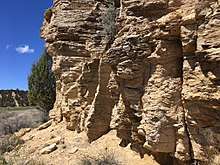Encrinite
Encrinites are a type of grain-supported bioclastic sedimentary rock in which all or most of the grains are crinoid ossicles. In older literature, the word is sometimes used to refer to individual fossil crinoids, but this usage is obsolete.

Encrinite within the Carmel Formation (Middle Jurassic) exposed at Mt. Carmel Junction, Utah. This is one of the youngest encrinites.
_KY.jpg)
Encrinite (crinoidal limestone) from the Mississippian Ft. Payne Formation of southern Kentucky
Example encrinite from the Silurian Brassfield Limestone of Ohio. Note different sizes of ossicles present.
Distribution
Encrinites form in areas where disaggregated crinoid skeletal debris becomes concentrated, typically shallow warm euhaline seas. They are therefore very common in the Paleozoic rock record of North America and Eurasia, particularly during the Silurian through Early Devonian and the Early Mississippian age, when high sea levels created widespread epeiric seas. Some encrinites are also known from the Jurassic of North America and Western Europe.
gollark: C++ with words!
gollark: Esolang idea: A thing like Unary, but where the unary encoding is replaced with an English number.
gollark: What about Mars? Everyone knows it's a star.
gollark: The stars are unaligned.
gollark: C = 🌵
References
- Ausich, W.I. 1997. Regional encrinites: a vanished lithofacies. In: Paleontological events: stratigraphic, ecologic and evolutionary implications, p. 509-519. Columbia University Press, New York.
- Hunter, A.W. and Zonneveld, J.P. 2008. Palaeoecology of Jurassic encrinites: reconstructing crinoid communities from the Western Interior Seaway of North America. Palaeogeography, Palaeoclimatology, Palaeoecology 263: 58-70.
This article is issued from Wikipedia. The text is licensed under Creative Commons - Attribution - Sharealike. Additional terms may apply for the media files.